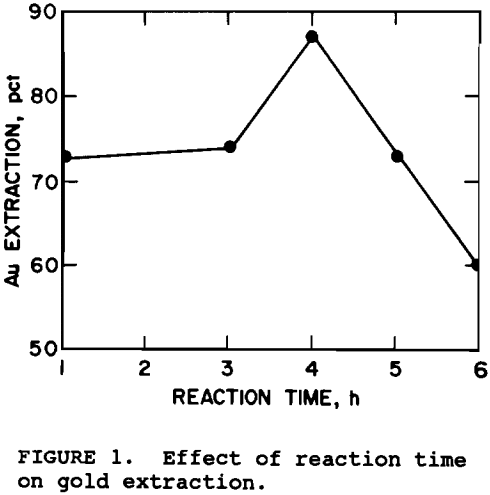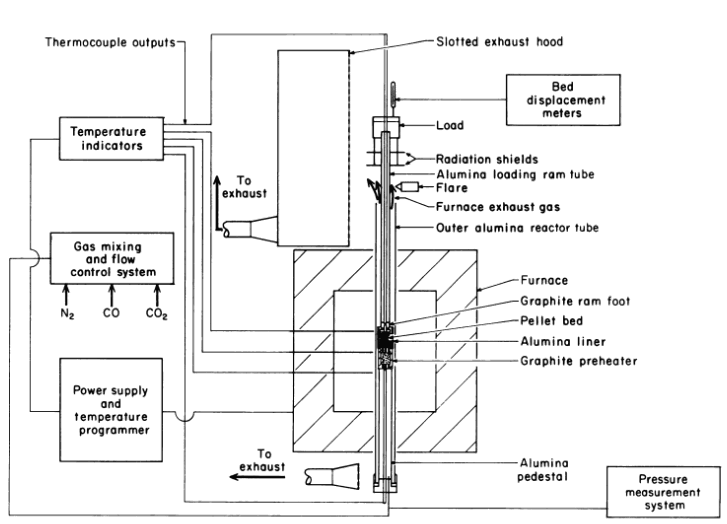Gold Sulphide Ore Oxidation by Alkaline Pressure

The U.S. Bureau of Mines developed an alkaline oxidative pretreatment to increase the recovery of gold from refractory sulfide ores containing arsenopyrite (FeAsS) and/or pyrite (FeS2). Pretreatment of a low grade ore containing 0.4% FeAsS, 3.5% FeS2, and 2.74g/mt Au with 1.2M NaOH, 40 psig 02, 100° C, and 4 hr in a 2-L autoclave […]
Iron Oxide Pellets

Develop methods of enhancing and measuring the high-temperature softening and melting properties of iron oxide pellets reduced under simulated blast furnace smelting conditions. Add dolomite and limestone flux and a low-cost organic binder, such as starch, carboxyl methylcellose (CMC), or waste papermill sludge, to the iron oxide concentrate to produce hematite (ferric oxide) pellets with […]
Laboratory Zadra Electrolytic Cell
A ZADRA electrolytic cell adapted to strip gold from sulfide solutions thereof which comprises a cathode assembly having a vertical metallic pipe adapted to deliver gold-bearing solution to the cell and to serve as a negative bus bar for delivering electric current to said cell, said pipe being axially positioned in said cell and being […]
Placer Mining Equipment
Specific placer mining equipment is needed for each of the methods which can be classified according to the several methods of excavating and transporting the gravel, or they may be designated to correspond with the various ways of saving the gold. The actual moving of the gravel from place is always the principal concern of […]
Sampling Placer Deposits by Drilling
The sampling of placer deposits by drilling or, more precisely, drive-pipe sampling, is discussed in detail by Janin. He states that the Keystone no. 3 traction machine is used generally in California. The usual casing is 6 inches inside diameter and 3/8 inch thick, in 5- to 7-foot sections. Drilling without casing is not good […]
Placer Gold Prospecting Equipment
The outfit to be taken on a prospecting trip depends upon the mode of transportation, the work contemplated, and the funds available. Enough equipment should be taken, but unnecessary articles make extra work. When a more or less permanent camp is established, added equipment for personal comfort and efficiency can be obtained. Usually a cabin […]
Gold Placer Sampling and Estimation
Failure to sample and estimate properly the available yardage of placer deposits has resulted in a tremendous waste of money and effort. A large proportion of all placer operations has failed because the gold in the gravel was insufficient to repay the cost of even the most efficient mining, not to mention the return of […]
Minerals Associated or Found in Gold Placer Gold
Associated Minerals: Placer gold invariably is accompanied by other heavy minerals, which comprise the black, white, or yellow concentrates found in the sluice box when cleaning up. Table 3 lists these minerals roughly in the order of their commonness. Some of the characteristics noted under Remarks apply chiefly to the minerals as they are found in […]
Zirconium Crucibles
Zirconium crucibles are rapidly becoming a standard piece of equipment, particularly in laboratories where fusions using strongly alkaline fluxes are common. This Center has found no better material to use for the thousands of sodium peroxide fusions that are done here every year. Zirconium crucibles usually arrive from their suppliers in a polished, silvery state. […]
Acid Digestion of Ferrochrome Metal
At times it may be necessary or desirable to dissolve a ferrochrome sample in acid rather than fusing it in sodium peroxide. Acid digestion methods are slow, but require little in the way of attention. Two alternative methods are described here. The A method is the basic method to use for most ferrochrome samples. The […]
